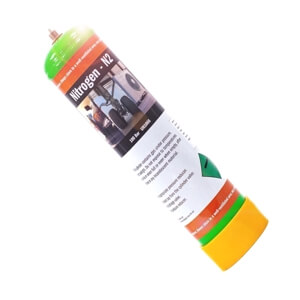Nitrogen COSHH Assessment Form

A three-page COSHH Assessment Form, with some example text reading:
Health risks: Inhalation
Skin contact: Adverse effects are not expected from this product.
Eye contact: Adverse effects are not expected from this product.
Ingestion: Ingestion is not considered a potential route of exposure.
Inhalation: In high concentrations, it may cause asphyxiation. Symptoms may include Cardiac sensitisation, anaesthetic effects, light-headedness, dizziness, confusion, lack of coordination, drowsiness, and unconsciousness.
Nitrogen plays a crucial role in refrigeration systems. It is primarily utilised as a refrigerant due to its remarkably low boiling point and substantial heat capacity. Liquid nitrogen is employed for rapid freezing processes, while nitrogen gas serves essential functions in purging and leak testing within refrigeration and HVAC systems.
Liquid nitrogen is an exceptionally effective refrigerant because it can absorb significant heat as it transitions from liquid to gas. This phase change occurs at a boiling point of -196 degrees Celsius (-321 degrees Fahrenheit), allowing it to achieve rapid cooling efficiently. This property makes liquid nitrogen ideal for applications that require extremely low temperatures, such as flash freezing of food items, preserving the texture and quality of the products, and cryogenic preservation of biological samples and medical materials.
In refrigeration and HVAC systems, nitrogen gas is extensively used for purging lines and various system components. By introducing dry nitrogen into the system, technicians can effectively eliminate impurities, moisture, and other contaminants that might compromise the integrity or performance of the refrigeration cycle. This purging process is vital in maintaining the system's efficiency and longevity, preventing the formation of ice or corrosion caused by moisture.
Furthermore, nitrogen gas plays a critical role in the leak testing phase of refrigeration systems prior to the introduction of refrigerants. By pressurizing the system with nitrogen, technicians can conduct thorough inspections to detect any leaks. This step is essential not only for ensuring the system's operational efficacy but also for preventing the loss of refrigerant, which can be both economically and environmentally detrimental. A leak-free system is fundamental to achieving optimal performance and energy efficiency, adhering to regulatory standards, and reducing greenhouse gas emissions associated with refrigerants.
This document is:
- Recognised by local authorities
- Recognised by principal contractors
- Suitable for CDM sites
- Approved by H&S managers
If you want others to have confidence in your company, download and buy the proper documents today.
As with all our documents, our risk assessments are in Word™ format and available for instant download and use. You only need to buy them once.
Once you buy and download this document, it’s yours for life to use repeatedly.
Why not browse the HSEDocs catalogue of method statements, risk assessments, COSHH assessments, or industry-specific packages?
And for safety training relevant to your job, visit our online training courses.
GET THIS DOCUMENT
£8.99+VAT
- Available in Word™
- Fully customisable
- Add your Company Logo
- UK & EU Compliant

 CART
CART 